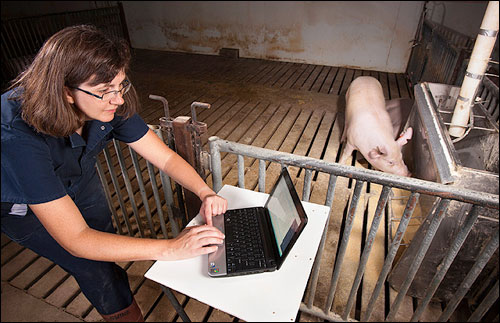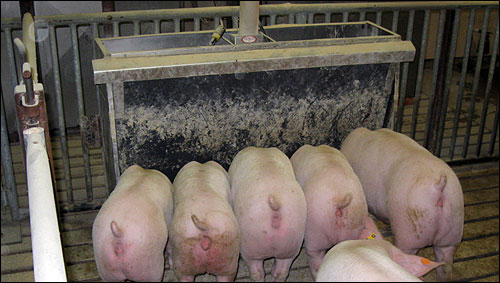Two agricultural engineers working for the U.S. Department of Agriculture (USDA) have developed an animal feeding behavior-monitoring system that employs radio frequency identification readers, antennas and multiplexers to gauge the health of livestock. The system has been in operation for several years at the Roman L. Hruska U.S. Meat Animal Research Center (USMARC), located in Clay Center, Neb. It is intended to capture the unique tag ID number of each animal that puts its head into a feed bunk or trough, and to do so without altering or restricting the way in which the animals feed. With data collected from the system, scientists can identify which animals are eating, where in the trough they congregate, for how long and how frequently. These measures provide insight into an individual animal’s response to environmental changes, and can also potentially identify sick animals.
The system was developed by Tami Brown-Brandl and Roger Eigenberg, who work in the center’s Environmental Management Research Unit. The two agricultural engineers investigated existing RFID-based systems to monitor feed intake. While many solutions were available that can monitor feed intake, those products substantially alter the normal feeding process, thereby potentially influencing the animals’ behavior. The USMARC engineers’ goal was to monitor animals within a commercial-type environment. A new system was thus required that could monitor animals’ feeding behavior without affecting their normal activities.

The team designed a method to distribute the radio-frequency signal to a series of antennas, using multiplexers constructed in-house. One type of multiplexer is used to distribute a read command to multiple readers, while a second type allows a single interrogator to scan multiple antennas within a particular pen. Eigenberg designed the hardware, while Brown-Brandl developed the software that controls the hardware, timing, and data recording and storage.
The system was originally installed in 16 research cattle feedlot pens, each designed to hold eight steers or heifers. Eight of the 16 pens provided the animals with access to shade—a method of reducing the effects of summer heat. Six reader antennas and a multiplexer were installed in the hollow core of a 12-foot polystyrene bunk. The total setup consisted of 16 bunks, two Texas Instruments Series 2000 low-frequency (LF) RFID readers, connected to 96 antennas, and 18 multiplexers. The system can accommodate 128 animals, and the antennas were designed to read tags within the feed bunk at a maximum of 30 inches. The animals were tagged with Allflex half-duplex 134.2 kHz RFID tags (compliant with the ISO 11784 and 11785 standards), affixed to their ears.
Researchers also created software compatible with the Microsoft Windows operating system that linked each cow’s ID number to the location at which its tag was read, and transferred that information to a text file for later analysis. The cattle-monitoring system scans all antennas, recording data every 30 seconds. The software also displayed a screen to provide diagnostics for the hardware when operated in test mode, during which every bunk and antenna can be checked in order to ensure that all antennas are reading tags properly.
According to Eigenberg and Brown-Brandl, the feedlot system has successfully collected each individual animal’s feeding behavior throughout two research cycles. The scientists are now summarizing the data for analysis.
A similar system was adapted to monitor swine at a commercial barn. This facility was designed with a capacity of 240 pigs, with a total of six pens able to accommodate 40 animals apiece. Every pen has a five-hole feeder, and each hole is equipped with a single reader antenna. A single multiplexer, housed in a panel constructed of polyvinyl chloride (PVC) plastic, manages the signals to those antennas. The panel housing the electronics was affixed to the feeder’s front, Brown-Brandl says, and the modified feeder was functionally equivalent to an unaltered commercial model.
The swine-tracking system utilizes similar LF RFID tags specially developed for installation in pigs’ ears. Each tag transmits its unique ID, which is then captured by the antenna within a distance of up to 8 inches, or when the tag is located in the feeder’s trough.

The software, which was adapted from the cattle-tracking system to collect data within the swine facility, takes only 20 seconds to collect information from all feeder antennas. The technology, the scientists report, has been validated using video records.
The swine-monitoring system has shown some interesting patterns in feeding behavior, Brown-Brandl says. For example, she reports, pigs increase the amount of time they spend eating as they grow from two months of age until about three-and-a-half months. What’s more, male pigs spend more time eating than females, and faster-growing swine spend more time eating than their slower-growing counterparts. “However, the most intriguing outcome occurred during disease outbreak,” she states. “Identification of sick animals was apparent based solely on time spent eating.”
Feeding behavior has proven to be a valuable measure of individual animal status, Brown-Brandl says, thus demonstrating the potential of individual animal management to improve health and well-being. Before the system can be deployed in commercial settings, she notes, it requires further evaluation, validation and development, though it does show promise for the future of livestock production.

